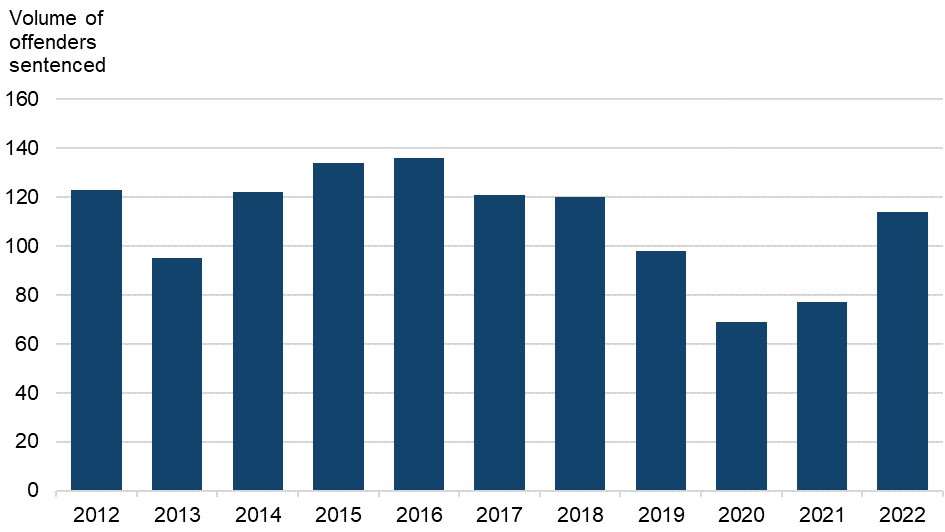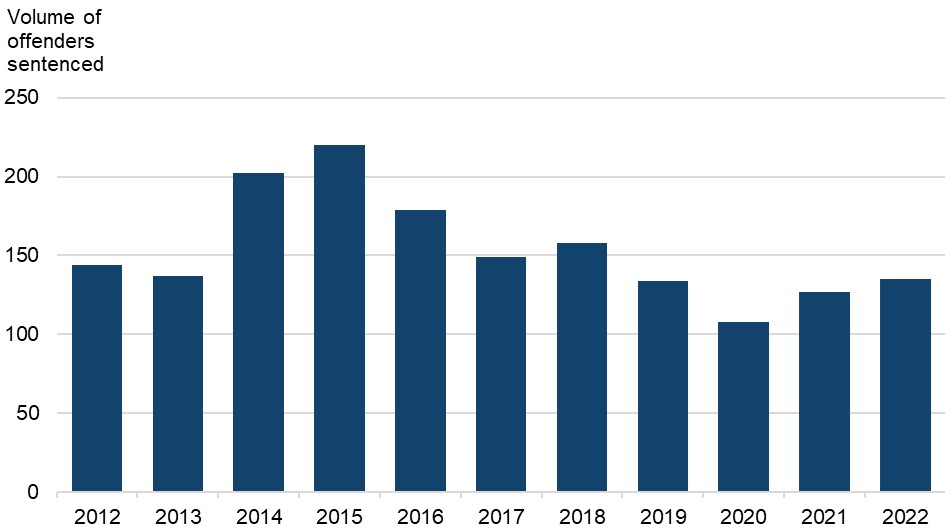Introduction
This bulletin provides information on volumes and sentence outcomes for adult offenders (aged 18 or over at the time of conviction) sentenced for offences covered by the Sentencing Council’s draft guidelines on the offences of kidnap, false imprisonment and blackmail. There are two draft guidelines covering the following offences:
- Kidnap and false imprisonment, common law offences
- Blackmail, Theft Act 1968 (section 21)
There are no existing guidelines for the offences of kidnap and false imprisonment, or the offence of blackmail.
The Court Proceedings Database (CPD), maintained by the Ministry of Justice, is the data source for this bulletin. For more information on this data source please see the ‘Further information’ section at the end of this document.
Additional figures for this offence, including breakdowns by demographic groups (sex, age group and ethnicity), can be found in the data tables which are available to download as Open Document spreadsheets on the Sentencing Council: Publications webpage.
Kidnap
Sentence volumes
Volumes of adult offenders sentenced for kidnapping broadly declined across the period 2017 to 2021, but in 2022 have seen an increase, with around 110 adults sentenced (see figure 1). This offence is indictable only and therefore all offenders were sentenced in the Crown Court.
Figure 1: Number of adult offenders sentenced for kidnapping, 2012 to 2022

Sentence outcomes
In 2022, as in previous years, the majority of offenders sentenced for kidnapping were sentenced to immediate custody (82 per cent). A further 10 per cent were ‘Otherwise dealt with’ (see the ‘Further information’ section for more details), and 6 per cent received a suspended sentence. The remaining offenders received either a community sentence (1 per cent) or a discharge (1 per cent).
Sentence lengths
The statutory maximum sentence for this offence is life imprisonment. The average (mean) custodial sentence length (ACSL) for kidnapping in 2022 was 5 years 9 months. Of those sentenced to immediate custody, 82 per cent received a custodial sentence post guilty plea of up to, and including, 8 years.
False imprisonment
Sentence volumes
Around 110 offenders were sentenced for false imprisonment in 2022 (see figure 2). Volumes of offenders sentenced for this offence have fluctuated in recent years following a sharp decline after 2016, when nearly 190 offenders were sentenced. This offence is indictable only and therefore all offenders were sentenced in the Crown Court.
Figure 2: Number of adult offenders sentenced for false imprisonment, 2012 to 2022

Sentence outcomes
The majority of offenders (82 per cent) sentenced for false imprisonment were sentenced to immediate custody in 2022. A further 7 per cent were ‘Otherwise dealt with’, and 6 per cent received a suspended sentence. The remaining offenders received a community sentence (4 per cent) or a discharge (1 per cent).
Sentence lengths
The statutory maximum sentence for this offence is life imprisonment. The ACSL for false imprisonment in 2022 was 4 years 6 months. Of those sentenced to immediate custody, just over three quarters (77 per cent) received a custodial sentence post guilty plea of up to, and including, 6 years.
Blackmail
Sentence volumes
In 2022, around 140 offenders were sentenced for blackmail. Figure 3 shows that volumes seem relatively stable following a general decline between 2015 and 2019. This offence is indictable only and, therefore, all offenders were sentenced at the Crown Court.
Figure 3: Number of adult offenders sentenced for blackmail, 2012 to 2022

Sentence outcomes
Almost all offenders sentenced for blackmail receive a custodial sentence. In 2022, around 73 per cent of offenders were given an immediate custodial sentence and 24 per cent were given a suspended sentence. Around 2 per cent were ‘Otherwise dealt with’ and the remaining 1 per cent of offenders received a community sentence.
Sentence lengths
The statutory maximum sentence for this offence is 14 years’ custody. The average (mean) custodial sentence length in 2022 was 2 years 10 months; this is broadly consistent with previous years. In 2022, around 95 per cent of offenders sentenced to immediate custody received a sentence length of up to, and including, 6 years.
Further information
Volumes of sentences
The data presented in this bulletin only include cases where the offence detailed was the principal offence committed. When an offender has been found guilty of two or more offences, the principal offence is the offence for which the heaviest penalty is imposed. Where the same disposal is imposed for two or more offences, the offence selected is the offence for which the statutory maximum penalty is the most severe. Although the offender will receive a sentence for each of the offences that they are convicted of, it is only the sentence for the principal offence that is presented in this bulletin.
Sentence outcomes
The outcomes presented are the final sentence outcomes, after taking into account all factors of the case, including whether a guilty plea was made. This is because the sentence length information available in the Court Proceedings Database (CPD) is the final sentence imposed, after any reduction for guilty plea. Sentence outcomes presented in this bulletin are therefore not directly comparable to outcomes in the sentencing guideline tables, which instead show starting point sentences before a guilty plea has been entered.
General conventions
Actual numbers of sentences have been rounded to the nearest 100, when more than 1,000 offenders were sentenced, and to the nearest 10 when fewer than 1,000 offenders were sentenced.
Proportions of sentencing outcomes have been rounded to the nearest integer. Percentages in this report may not appear to sum to 100 per cent, due to rounding.
Data sources and quality
The CPD, maintained by the Ministry of Justice (MoJ), is the data source for these statistics. Every effort is made by MoJ and the Sentencing Council to ensure that the figures presented in this publication are accurate and complete. However, it is important to note that these data have been extracted from large administrative data systems generated by the courts and police forces. As a consequence, care should be taken to ensure data collection processes and their inevitable limitations are taken into account when those data are used.
Further details of the processes by which MoJ validate the records in the CPD can be found inside the ‘Technical Guide to Criminal Justice Statistics’ within the Criminal Justice System Statistics Quarterly (CJSQ) publication.
The data in this report were generated using the Ministry of Justice’s (MoJ) Court Proceedings Database (CPD), aligning with figures published in the Criminal Justice System statistics quarterly: December 2022 publication (CJSQ) which was originally published in May 2023. Since then, the CJSQ publication has been revised to reflect changes to the underlying data, which have not been reflected in these statistics. As such, the latest MoJ published statistics will not match the statistics in this report. Further information on changes to MoJ’s data processing can be found in the changes and revisions section of the latest publication.
The average custodial sentence lengths (ACSLs) presented in this statistical bulletin are mean average custodial sentence length values for offenders sentenced to determinate custodial sentences, after any reduction for guilty plea.
‘Otherwise dealt with’ covers miscellaneous disposals. Please note that due to a data issue currently under investigation, there are a number of cases which are incorrectly categorised in the CPD as ‘Otherwise dealt with’. Therefore, these volumes and proportions should be treated with caution.
Figures presented include the time period from March 2020 in which restrictions were initially placed on the criminal justice system due to the coronavirus (COVID-19) pandemic, and the ongoing courts’ recovery since. It is therefore possible that these figures may reflect the impact of the pandemic on court processes and prioritisation and the subsequent recovery, rather than a continuation of the longer-term series, so care should be taken when interpreting these figures.
Contact points for further information
We would be very pleased to hear your views on our statistical bulletins. If you have any feedback or comments, please send them to: research@sentencingcouncil.gov.uk
Responsible Statistician: Lauren Maher and Sharmi Nath
Press Office enquiries: Kathryn Montague Tel: 020 7071 5792
Further information on the Sentencing Council and its work can be found on the Sentencing Council webpage.